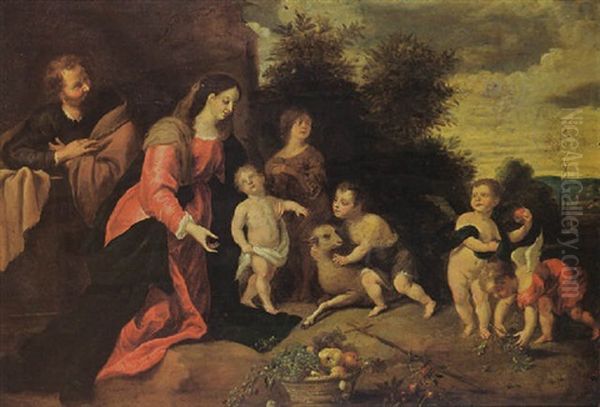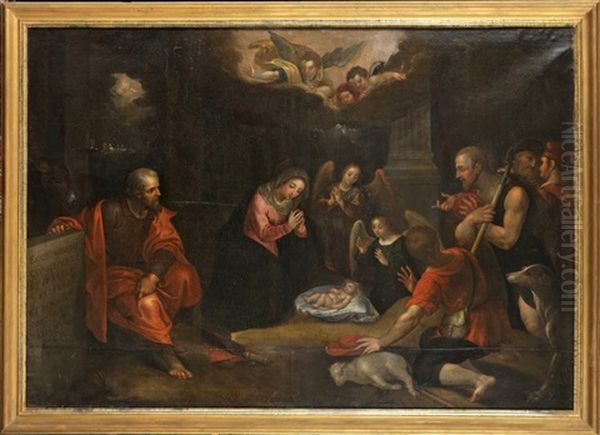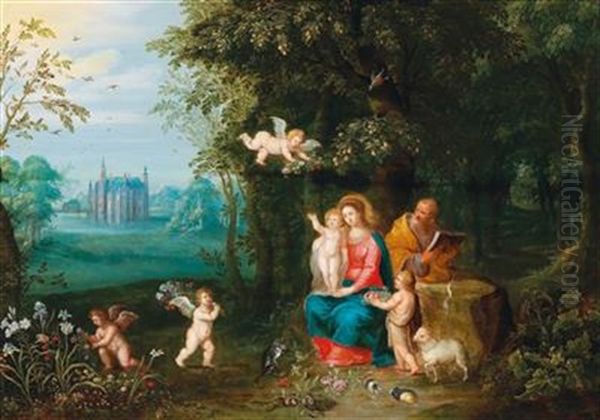
The first half of the 17th century marked a period of extraordinary artistic flourishing in Antwerp. Despite political and economic challenges, the city remained a vibrant hub for painters, sculptors, and printmakers, fostering a highly specialized and collaborative environment. Within this dynamic milieu, Peeter van Avont (1600-1652) carved out a distinct niche for himself as a painter renowned for his delicate and graceful figures, often contributing his specialized skill to the works of other prominent masters, particularly landscape and still life painters. While perhaps less universally known today than giants like Peter Paul Rubens or Anthony van Dyck, Van Avont was a respected member of the Antwerp artistic community, a master in his own right, and a frequent collaborator whose contributions significantly enriched the Flemish Baroque tradition.
Early Life and Artistic Formation
Peeter van Avont entered the world in Mechelen, a city with its own rich artistic heritage, located not far from Antwerp. He was baptised in Antwerp on January 14, 1600. Artistry ran in his family; his father, Hans van Avont, was a sculptor, suggesting that Peeter was exposed to artistic practice from a young age. While concrete details about his formal training remain scarce, it is plausible he received initial instruction from his father or was apprenticed to another master within the bustling Antwerp art scene. The environment itself, teeming with workshops and skilled practitioners, would have provided an immersive education.
By his early twenties, Van Avont was ready to establish himself independently. In 1622, he married Catherine van Hertsen in Antwerp. This significant personal milestone coincided with his professional launch. In the guild year 1622-1623, he was officially registered as a master painter ('wijnmeester', indicating the son of an existing master, though his father was primarily a sculptor) in the prestigious Antwerp Guild of Saint Luke. Membership in the Guild was essential for any artist wishing to practice professionally, take on apprentices, and sell their work legally within the city. This marked the formal beginning of a career that would span three decades.
Establishing a Signature Style: Delicacy and Grace

Peeter van Avont developed a highly recognizable style, particularly in his rendering of the human form. His figures, whether depicting holy personages, mythological beings, or ordinary children, are characterized by a remarkable delicacy and grace. They often possess smooth, almost porcelain-like skin, rounded features, and gentle postures. He showed a particular fondness and skill for depicting children and putti (cherubic infants), capturing their innocence and playful energy with sensitivity.
His compositions, especially in his independent works, tend towards harmony and balance. While working firmly within the Flemish Baroque tradition, his approach often favoured refinement and elegance over the dramatic dynamism seen in the grander works of Rubens or Jacob Jordaens. His colour palette was typically bright and clear, employing harmonious tones that contributed to the overall gentle and often idyllic mood of his paintings. This distinctive style made him an ideal candidate for specific artistic tasks, particularly the addition of figures to works by specialists in other genres.
The Art of Collaboration: A Hallmark of Antwerp Painting
The Antwerp art world of the 17th century was characterized by a high degree of specialization. Painters often focused on specific genres like landscape, seascape, still life, animals, or history painting. This specialization fostered a culture of collaboration, where two or more artists would combine their unique skills on a single canvas. This practice was driven by both artistic considerations – achieving a higher quality result by leveraging individual expertise – and economic efficiency, allowing workshops to produce diverse and high-quality paintings more rapidly for the demanding art market. Peeter van Avont became one of the most sought-after collaborators for his skill in figure painting, known as staffage.
Partnership with the Brueghel Dynasty
Among Van Avont's most notable collaborations were those with members of the illustrious Brueghel family, famed for their detailed landscapes and exquisite flower paintings. He worked closely with Jan Brueghel the Elder, one of the most celebrated artists of the era. A prime example of their partnership is The Holy Family in a Flower and Fruit Garland (c. 1623, Alte Pinakothek, Munich). In this work, Jan Brueghel the Elder meticulously rendered the lush, vibrant garland teeming with flowers and fruit, while Van Avont painted the tender scene of the Holy Family nestled within the central cartouche. The contrast between Brueghel's detailed naturalism and Van Avont's softly rendered figures creates a harmonious and devotional image.

This collaborative relationship extended to Jan Brueghel the Younger after the elder Brueghel's death in 1625. Van Avont continued to provide figures for landscapes and garlands produced in the Brueghel workshop, maintaining a stylistic continuity appreciated by patrons. Works like A Garland of Flowers with the Holy Family and Angels exemplify this ongoing partnership, showcasing Van Avont's ability to adapt his figures seamlessly into the compositions created by the Brueghels. His figures add narrative focus and human warmth to the intricate natural settings.
Enriching Landscapes: Figures for Specialist Painters
Beyond the Brueghels, Van Avont frequently lent his talents to numerous landscape specialists active in Antwerp and Brussels. His ability to paint small, lively figures perfectly suited the detailed woodland scenes, panoramic vistas, and idyllic pastoral landscapes favoured by artists such as Lucas van Uden, Jan Wildens (a frequent collaborator of Rubens), Jacques d'Arthois, Alexander Keirincx, and Gysbrecht Leytens (often known as the Master of the Winter Landscapes).
In these collaborations, the landscape painter would typically complete the natural setting first, leaving spaces for Van Avont to later add the figures. These figures could be mythological characters enacting a story, biblical figures in a natural setting, or simply peasants and travellers animating the scene. His contributions provided narrative context, scale, and visual interest, transforming purely scenic views into populated, engaging worlds. He also collaborated occasionally with artists like David Vinckboons and Sebastiaen Vrancx, who often depicted lively genre scenes or landscapes requiring numerous small figures.
Garlands, History Painting, and Hendrick van Balen
Van Avont also collaborated with figure and history painters, sometimes contributing specific elements to their compositions or working alongside them on complex allegorical pieces. A significant collaborator in this vein was Hendrick van Balen the Elder, known for his small-scale mythological and religious cabinet paintings, often executed on copper for a smooth, detailed finish. Van Avont and Van Balen worked together on pieces like the Garland of Fruit surrounding Cybele receiving gifts from Putti representing the Four Seasons (Belfius Collection, Brussels). In such works, one artist might paint the central scene while the other executed the surrounding decorative elements, or they might share the figure painting duties. This partnership highlights the intricate network of artistic relationships in Antwerp. His style complemented that of other contemporaries like Frans Francken the Younger, who also specialized in detailed small-scale narrative scenes.
Printmaking and the Paedopaegnion

Van Avont's skill in depicting children found another outlet in printmaking. He provided the designs for a series of engravings titled Paedopaegnion (Children's Games), expertly engraved by the renowned Bohemian artist Wenceslaus Hollar around 1647. This series charmingly illustrates various games and activities of children, showcasing Van Avont's keen observation and ability to capture youthful energy and form. The collaboration with Hollar, a master engraver who worked across Europe, ensured wider dissemination of Van Avont's designs, contributing to his reputation beyond the realm of painting. These prints remain valuable records of childhood representation in the 17th century.
Independent Works: Religious and Mythological Themes
While highly regarded as a collaborator, Peeter van Avont also produced independent works where he was responsible for the entire composition. Religious subjects were a mainstay of his oeuvre, reflecting the strong influence of the Counter-Reformation in Flanders. He painted numerous versions of the Holy Family, often depicted in intimate, tender moments, sometimes accompanied by the infant Saint John the Baptist and angels. Examples like The Holy Family with the Infant John the Baptist and Angels demonstrate his ability to convey piety and familial warmth through his characteristic gentle style.
He also tackled mythological and allegorical themes, popular subjects among Antwerp patrons. Nymphs, satyrs, bacchanalian scenes, and allegories like The Four Elements appear in his independent work. These paintings often feature his signature graceful figures, frequently including playful putti, set within idyllic landscapes that he himself painted or perhaps commissioned from a landscape specialist. These works allowed him to fully express his own compositional ideas and stylistic preferences, often favouring serene or joyous moods over high drama. His approach to these themes sometimes echoes the work of contemporaries like Frans Wouters, who also specialized in small-scale mythological cabinet pictures.
Civic Life and Art Dealing
Like many successful artists of his time, Peeter van Avont participated in the civic life of Antwerp. From 1633, he served as captain of the local civic militia, or schutterij, a position of some social standing. His involvement indicates his integration into the city's bourgeois society. He was also briefly associated with the chamber of rhetoric 'De Violieren,' which was closely linked to the Guild of Saint Luke, suggesting an interest in literary and theatrical pursuits common among artists and intellectuals.
Furthermore, Van Avont engaged in the art trade. His expertise was recognized to the extent that he was involved in the appraisal of the estate of Peter Paul Rubens after the latter's death in 1640. This role not only underscores his respected position within the art community but also suggests business acumen and a deep understanding of the art market. Dealing in art provided an additional source of income and kept him connected to the flow of artworks and patronage within Antwerp and beyond.
Context within the Antwerp School
Peeter van Avont operated within the orbit of the towering figures of the Antwerp school, Peter Paul Rubens and Anthony van Dyck. While his style differed significantly – favouring delicacy and refinement over their powerful dynamism and psychological depth – he undoubtedly absorbed aspects of the prevailing Baroque aesthetic. The emphasis on rich colour, emotional expression (albeit gentler in Van Avont's case), and complex compositions are all hallmarks of the era.
His specialization in figures for landscapes and garlands places him alongside other highly skilled specialists who contributed to Antwerp's fame, such as the animal painters Frans Snyders and Jan Fyt, or the architectural painter Pieter Neefs the Elder. This collaborative system, often orchestrated by dealers or lead masters, allowed Antwerp workshops to produce an astonishing variety and quantity of high-quality art. Van Avont's reliable skill in rendering graceful figures made him an indispensable part of this artistic ecosystem, working alongside landscape masters like Jan Wildens and Jacques d'Arthois, and figure painters like Hendrick van Balen.
Later Years and Legacy
Peeter van Avont remained active as an artist throughout the 1640s. He passed away in Deurne, near Antwerp, and was buried on November 1, 1652. He left behind a significant body of work, both independent paintings and numerous collaborative pieces housed in major museums and private collections across the world.
While detailed biographical information remains somewhat limited compared to the most famous Flemish masters, Peeter van Avont's artistic contribution is clear. He was a master of the delicate and graceful figure, particularly children and putti. His ability to seamlessly integrate his figures into the works of renowned landscape and still life specialists made him a highly valued collaborator in the thriving Antwerp art market. His independent works further showcase his refined style and sensitivity in handling religious and mythological themes. Peeter van Avont stands as a significant representative of the specialization and collaborative spirit that defined the Golden Age of Antwerp painting, a skilled artist whose elegant figures continue to charm viewers centuries later. His work offers a valuable counterpoint to the grander styles of his contemporaries, highlighting the diversity and richness of the Flemish Baroque.